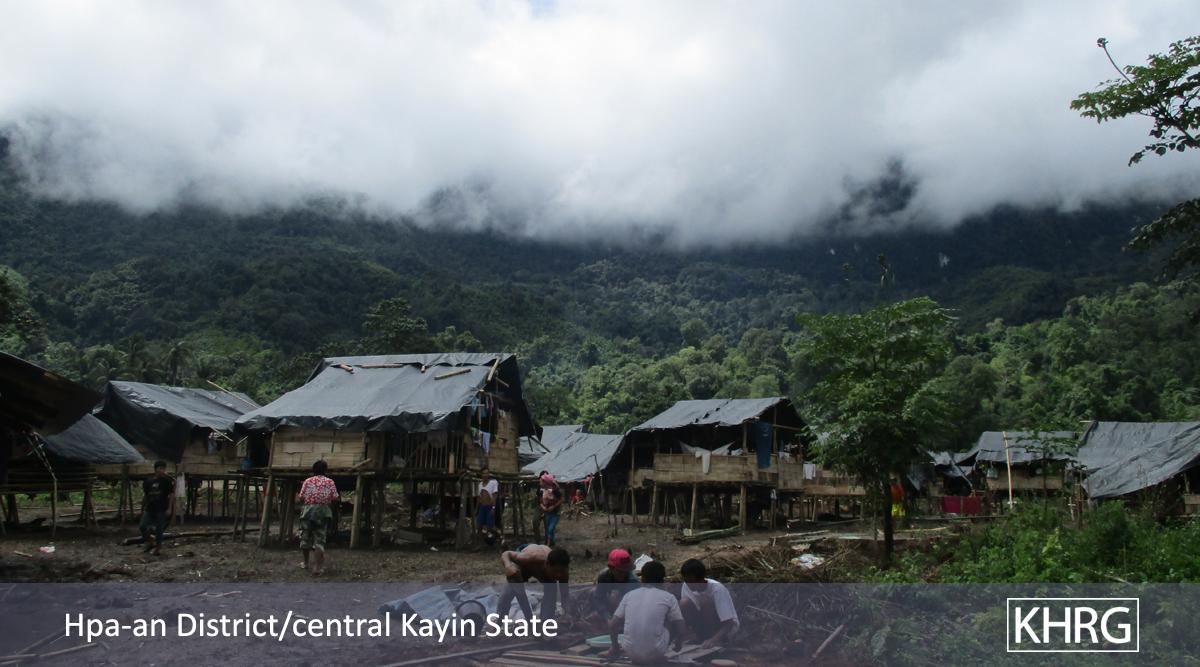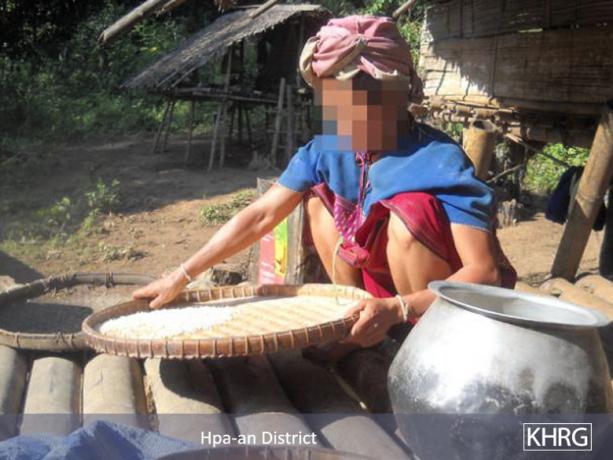This report contains the full transcript of an interview conducted during November 2011 in Lu Pleh Township, Pa'an District by a villager trained by KHRG to monitor human rights conditions. The villager interviewed Naw G---, a 40-year-old Buddhist hillfield farmer who described an incident in which her son-in-law, Saw A---, 36, was shot and killed by patrolling Tatmadaw soldiers from IB #230. Naw G--- explained that Saw A--- was cooking with KNLA soldiers in Naw G---'s house, when Tatmadaw soldiers entered P--- village. According to Naw G---, the soldiers fired at Saw A--- as he fled the house and the bullets hit the left side of his head, killing him instantly. A separate report of this incident written by the villager who conducted this interview, including 23 photos taken by the same villager, is available here. An interview with Naw G---'s son who was also present during the attack is available here.
Interview | Naw G--- (female, 40), P--- village, Lu Pleh Township, Pa'an District (November 2011)
The following interview conducted by a villager in Pa'an District is presented below translated exactly as it was received, save for minor edits for clarity and security.[1] It was received along with eight incident reports, seven other interviews, one situation update and 137 photographs.[2]
Ethnicity: Karen
Religion: Buddhist
Marital Status: Married
Occupation: Dry paddy hillfield farmer
Can you tell me about your experiences? I would like some information … [about] all the things you faced.
At the time I was ghu bu [threshing paddy with a bamboo tray], I saw them coming and I was afraid so I jumped to the ground from my house and ran away. After a while I came back to my house and I saw that they had burnt my bag, and taken my money and my earrings. When I saw this, my tears fell and I didn't know what to do.
Who were they?
They were the Burmese soldiers [Tamadaw].
How many of them?
There were six[3] soldiers.
What time did they come?
They came at 8:00 am.
When they came to the village did they call villagers [to follow them] or did they shoot immediately?
Yes, they called some villagers [to follow them] because they wanted Karen people to porter. When they came, we didn't dare to stay in the house and we ran away. Only those people and my son-in-law were left.
Who were the people he was with?
He was with green people [Karen National Liberation Army, KNLA soldiers].
Those people were green [KNLA soldiers]?
Yes, they were.
Why were they [the KNLA soldiers] here?
They were cooking rice.
Were they living here [at the time of the incident]?
No, they were cooking rice with my son-in-law. There was only one [KNLA soldier] here [with her son-in-law at the time- the other KNLA soldier was at the front of the house].
Did the Burmese Army [Tatmadaw soldiers] call [you and the other people in the house] to come down or did they shoot directly?
They shot directly.
What happened? Did anyone get injured?
Yes, the Burmese [soldiers] shot one person dead.
Who died?
My son-in-law.
What was his name?
His name was Saw A---.
How old was he?
He was 36 years old.
Where [on his body] did he get shot?
He got shot in his cheek and his cheek was law thalaw [blown off], and also in his buttocks. I think they shot him at close range.
Where was he when he got shot?
He got shot at the thay koh kaw ht [base of the tree]. His bag was hanging on the tree branch [where it became caught as he fell].
Which side was shot?
He got shot on his left side.
Did you see it with your own eyes?
Yes, I went to see his dead body with my own eyes.
Did you carry him?
I asked people to hold and carry him. I didn’t dare carry him because he was bleeding too much.
What did the Burmese soldiers do after they shot him?
After they shot him they ran away.
They didn’t stay there?
No, they didn’t stay.
What did you do with your son in law?
I made him a pu dah [split bamboo mat] and put him on that.
Was he bleeding?
Yes, he was bleeding a lot.
The place where he was shot, did people burn his blood that was left on the ground?
Yes, they burnt it.[4]
When he was shot, was your daughter there?
No, my daughter lives in L---.
Their house is there?
Yes, it is.
How long does it take [to travel] between L--- and here [P--- village]?
It takes 20 to 30 minutes.
I can’t go to see your daughter because she lives a bit far away, so can you tell me a little bit about her? After the Burmese Army shot [your son-in-law] did they loot anything from your house?
They took my earrings and money.
Did they take anything else?
No that’s all they took.
Nothing else?
One ring.
How many earrings?
Six pairs of earrings.
How much does each pair of earrings weigh?
I bought each pair of earrings for 3,000 baht (US $100).
How long ago did you buy them?
I bought them three years ago.
They weren’t inherited, right?
No, only one pair of earrings was inherited.
How much was the ring?
The ring cost 10,000 baht (US $333.33).
Baht or kyat?
Baht.
How long ago did you buy it?
Over four years ago.
Do you think you can buy that ring for 10,000 baht at this time?
No, you can’t buy the ring at that price anymore.
How much money did they take?
They took 20,000 baht (US $666.66).
Baht or kyat?
Baht, not kyat.
Did it [the money stolen] include kyat?
No, they only took baht.
Where did you keep it?
I kept it in my bag.
How did the Burmese soldiers know [it was there]?
They looked for it and they found it in the bag. I saw them taking my things but I didn’t dare go back because they were in my house.
Did they destroy your house?
No.
Did they steal anything else?
No, they didn’t.
Did the house get shot?
Yes, it was shot.
Where did they shoot?
There.
Where is there?
In the living room.
Do you know how many shots [were fired]?
I don’t know how many shots, but I guess ten.
Are there any other things that you want to report?
Here the ta dtaw koh [roofing beams] also got shot, you can see the holes, and they shot one pot and one water container made from bamboo, which were broken.
How about the other house, is that your house too?
No, that’s my niece’s house and they ransacked things [there too].
Can you tell me more about your son-in-law getting shot?
Yes, I can tell you.
What was the benefit for you when your son-in-law lived with you?
When he was alive he tried to work so hard for his family.
What was his livelihood?
He worked on the hill [as a hill farmer].
Did he have children?
Yes, he did.
How many children did he have?
He had three kids. The oldest one is a girl and the other two are boys.
How old is the oldest one?
She is six years old.
How about the youngest one?
The youngest is three years old.
How about your livelihood – what problems do you face?
We face problems, but we just have to get on with it.
How about your daughter, has she come back to stay with you?
Because of this [the shooting] she will have to come back to stay with me. She can’t live on her own. I’ll have to call her to come back to stay with me.
How long did you see the Burmese soldiers stay there [in P--- Village] for?
Not too long, when I saw them coming I ran to another place.
How many guns did they have with them?
I don’t know, but there were seven soldiers.
Did they stay long?
No, after they shot and destroyed things they went directly back.
How about the other villagers [from other villages] – did they beat and arrest them?
No, they didn’t. They only arrested people from this village.
Do you have anything more to mention?
No, I don’t know what else I should mention.
I just want to make sure one thing you said is right – you said they took 20,000 baht of your money, not kyat?
Yes, for sure it wasn’t kyat.
And you said your earrings and ring [were stolen] too?
Yes, six pairs of earrings and one ring, which amounts to about 20,000 kyat.
We want to see your daughter in person and interview her, but she lives a bit far away so we can’t. How old is your daughter?
She is 24 years old.
Do you remember the date of the incident?
It was a Saturday.
Do you know when?
It was two weeks ago.
Footnotes:
[1] KHRG trains villagers in eastern Burma to document individual human rights abuses using a standardised reporting format; conduct interviews with other villagers; and write general updates on the situation in areas with which they are familiar. When conducting interviews, villagers are trained to use loose question guidelines, but also to encourage interviewees to speak freely about recent events, raise issues that they consider to be important and share their opinions or perspectives on abuse and other local dynamics.
[2] In order to increase the transparency of KHRG methodology and more directly communicate the experiences and perspectives of villagers in eastern Burma, KHRG aims to make all field information received available on the KHRG website once it has been processed and translated, subject only to security considerations. As companion to this, a redesigned website will be released in 2012. In the meantime, KHRG's most recently-published field information from Pa'an District can be found in the report, "Pa'an Interview: Naw K---, September 2011," KHRG, January 2012.
[3] Note that later in this interview, Naw G--- says that there were seven Tatmadaw soldiers; this corresponds with an account provided by her son Saw C---, who was also present at the time of the attack. See "Pa'an Interview: Saw C---, October 2011," KHRG, December 2011.
[4] According to a KHRG researcher, this is carried out for practical hygiene reasons to clean the area and prevent disease, and also stems from an animist belief that accidental or unexpected death is the harbinger of bad luck in the village. It is believed that burning the area where blood fell will thwart bad luck and allow the spirit of the deceased to once again take human form.








